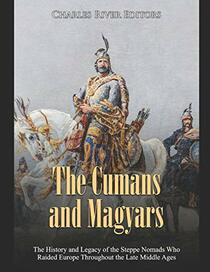Neither the Cumans nor the Magyars had a written language in their early days. Thus, most of the history comes from their enemies. Both groups started out pillaging and only after generations did they assimilate into other ethnic groups.
THE CUMANS --
Surprisingly, Cumans refers to their yellow hair. Unlike other Turkic groups, they were blond, with blue eyes, and fair skin. They were horse people and part of the CumanâKipchak confederation. From the late 800s, the Cumans were a fierce military and cultural force that could not be stopped. The monarchs of China to Hungary and Russia to the Byzantine Empire were savaged by the Cumans, often losing whole armies and even whole cities. The Cumans were not interested in settling; all they wanted were riches and plunder to take back to their homes in the steppes.
In 1223, the Mongols superseded the Cumans, whereas, the Cumans dispersed and integrated into various European and central Asian lands. In the beginning of the Cuman tribes, they practiced a shamanistic religion. Over the centuries, many Cumans joined the Christian faith. When many Cumans joined the Mongol Golden Horde, they became Muslims. Many Cuman helped found dynasties in Bulgaria, Hungary, and Romania.
This book spent some time explaining the difference in the Fourth Crusade (1202 - 1204) from previous and later conflicts. Essentially, this Crusade was between Western Crusaders (Catholic Europeans led by the Pope) and the Eastern Byzantium Empire (the Greek Orthodox Church). The Cumans played a decisive role here because they caused so much wanton destruction. When there wasn't much left to look, the Cumans returned to their homes north of the Danube. The Fourth Crusade was the turning point; after this one, the European Christians gradually lost their hold on the Holy Lands.
THE MAGYARS --
Although folks associate the Huns with Hungary, the truth is that the Magyars inhabited Hungary (and they are not related to the Huns). The most widely accepted belief is that the Magyars are related to the Finns and peoples of the Ural Mountains. Their language is not related to the other languages that surround them.
Before the year 1000 CE, the Magyars moved into the Carpathian Basin. Eventually, they moved on to Hungary and assimilated.
This is a somewhat dry explanation of the Cumans and Magyars.
THE CUMANS --
Surprisingly, Cumans refers to their yellow hair. Unlike other Turkic groups, they were blond, with blue eyes, and fair skin. They were horse people and part of the CumanâKipchak confederation. From the late 800s, the Cumans were a fierce military and cultural force that could not be stopped. The monarchs of China to Hungary and Russia to the Byzantine Empire were savaged by the Cumans, often losing whole armies and even whole cities. The Cumans were not interested in settling; all they wanted were riches and plunder to take back to their homes in the steppes.
In 1223, the Mongols superseded the Cumans, whereas, the Cumans dispersed and integrated into various European and central Asian lands. In the beginning of the Cuman tribes, they practiced a shamanistic religion. Over the centuries, many Cumans joined the Christian faith. When many Cumans joined the Mongol Golden Horde, they became Muslims. Many Cuman helped found dynasties in Bulgaria, Hungary, and Romania.
This book spent some time explaining the difference in the Fourth Crusade (1202 - 1204) from previous and later conflicts. Essentially, this Crusade was between Western Crusaders (Catholic Europeans led by the Pope) and the Eastern Byzantium Empire (the Greek Orthodox Church). The Cumans played a decisive role here because they caused so much wanton destruction. When there wasn't much left to look, the Cumans returned to their homes north of the Danube. The Fourth Crusade was the turning point; after this one, the European Christians gradually lost their hold on the Holy Lands.
THE MAGYARS --
Although folks associate the Huns with Hungary, the truth is that the Magyars inhabited Hungary (and they are not related to the Huns). The most widely accepted belief is that the Magyars are related to the Finns and peoples of the Ural Mountains. Their language is not related to the other languages that surround them.
Before the year 1000 CE, the Magyars moved into the Carpathian Basin. Eventually, they moved on to Hungary and assimilated.
This is a somewhat dry explanation of the Cumans and Magyars.




